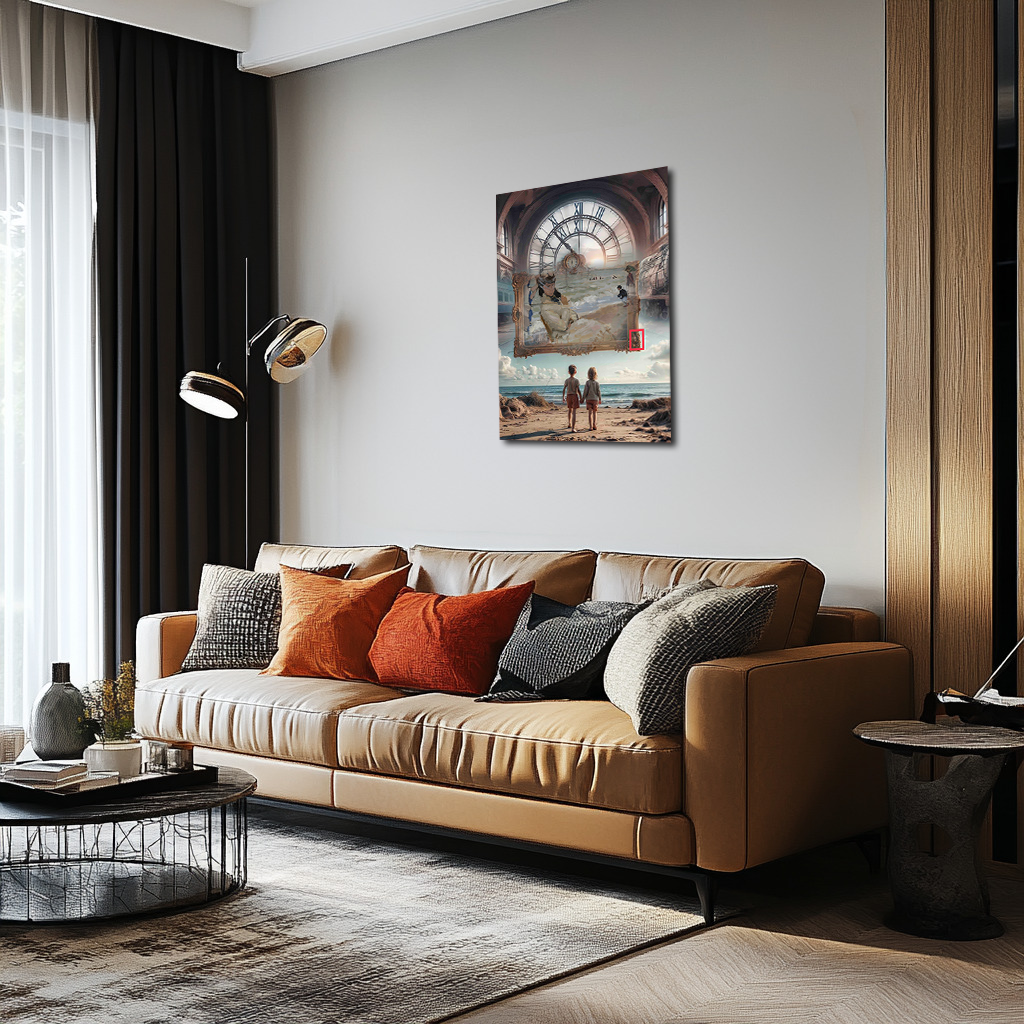Echoes of Time: Camille on the Beach at Trouville
"Echoes of Time: Camille on the Beach at Trouville" transforms Monet’s classic impressionist work into a conceptual exploration of memory and time. Encased within an ornate frame, Camille’s figure blends into a vast surrealist scene where an enormous clock looms overhead, marking the unstoppable passage of time. Trains symbolize movement and departure, while two children walk toward the ocean, representing the continuity of life. The colors—soft blues, warm sands, and golden highlights—echo Monet’s original palette, reinforcing themes of nostalgia and artistic immortality. This piece invites viewers to ponder the way memories persist, preserved through the delicate brushstrokes of history.
Please see Below for Details…
Hotline Order:
Mon - Fri: 07AM - 06PM
404-872-4663
This reimagining of Camille on the Beach at Trouville transforms Monet’s intimate seaside portrait into a conceptual journey through time and memory. Originally painted in 1870, Monet captured his wife Camille seated on the sunlit sands of Trouville, her delicate dress flowing in the ocean breeze. In this new interpretation, the artwork is framed within a surreal landscape where past, present, and future coalesce into a singular narrative.
At the heart of the composition, Monet’s painting remains intact, yet it appears as if suspended within a grand, antique frame. The brushstrokes of Camille’s form blend seamlessly with the surrounding environment, as if history itself is dissolving into the present. The ornate golden frame, adorned with subtle hints of time’s passage, floats weightlessly, suggesting the preservation of memories through art.
Above, an enormous clock dominates the background, its Roman numerals marking not just hours, but entire lifetimes. The clock, reminiscent of the iconic Gare d'Orsay station, symbolizes the inexorable movement of time. Trains flank either side, reinforcing themes of travel, departure, and fleeting moments. The misty atmosphere inside the station contrasts with the warmth of the seashore, reflecting the tension between nostalgia and forward motion.
Below, two children walk hand in hand toward the waves, representing innocence and the continuity of generations. Their presence suggests that time is not merely a linear force but a cycle, where past memories find new life in the experiences of the future. The waves before them echo the brushstrokes of Monet’s impressionist technique—fluid, ephemeral, ever-changing.
Monet’s original palette of soft blues, sandy whites, and golden hues is preserved but extended into the entire landscape. The blues of the sky and ocean symbolize serenity and infinite possibility, while the warm earth tones evoke the comfort of memory. The interplay of light and shadow mimics Monet’s impressionist style, where the passage of time is felt in every changing hue. The golden accents on the clock and frame highlight the significance of nostalgia, suggesting that treasured moments remain luminous even as time moves forward.
As an artist, I sought to bridge Monet’s era with our own, merging his delicate impressionist touch with a surrealist narrative. The painting of Camille is not simply a representation of a moment in the past; it is a doorway, a window through which we glimpse the fleeting nature of time and love. By placing the children below, I emphasize that the past is never truly lost—it lingers in the echoes of footsteps on the shore, in the brushstrokes of a masterpiece, in the stories we continue to tell.
This work explores the paradox of time: its inevitability and its preservation through art. Camille remains forever on the beach at Trouville, her presence immortalized in pigment and light. And yet, time carries forward, as seen in the motion of the children, the distant trains, the eternal ticking of the clock. Through this piece, I reflect on art’s ability to hold moments still, even as the world continues to change around them.
Add your review
Your email address will not be published. Required fields are marked *
Please login to write review!
Looks like there are no reviews yet.








